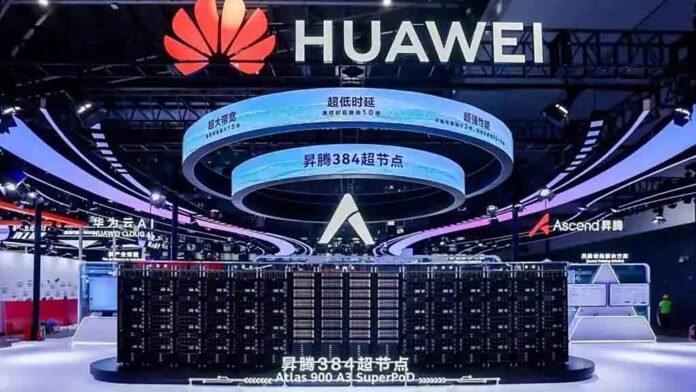Huawei is intensifying its position in the AI chip race by launching its new Ascend 910C and Ascend 910D chips, as well as unveiling a massive AI supercomputing cluster — all aimed at rivalling Nvidia’s dominance in the AI infrastructure space.
The Ascend 910C, currently being tested by major Chinese firms such as ByteDance, Baidu, and China Mobile, reportedly achieves up to 60% of the performance of Nvidia’s top-tier H100 chip when used for inference tasks.
Huawei has already shipped over 70,000 samples to partners, with orders estimated to be worth $2 billion. The chip is built on Huawei’s Da Vinci architecture and is produced by SMIC using a 7nm process, though yield rates remain a challenge due to limited access to advanced lithography tools.
Huawei also plans to roll out the Ascend 910D later this year. This chip is designed for ultra-large AI models and delivers over 35% higher performance than the 910C.
It is expected to rival Nvidia’s H100 and even challenge the upcoming Blackwell and Rubin GPUs in specific workloads. Initial samples are expected by late May, with broader deployment anticipated in Q4 2025.
CloudMatrix 384: Huawei’s Supercomputing Leap
At the recent World AI Conference (WAIC) in Shanghai, Huawei introduced its new AI cluster system called CloudMatrix 384. This system integrates 384 Ascend 910C chips and delivers up to 300 petaflops of BF16 performance — surpassing Nvidia’s GB200 NVL72 in raw compute power.
The cluster uses a proprietary “supernode” architecture with an all-optical mesh network, enabling ultra-low latency and high bandwidth across racks. However, it consumes nearly four times more energy than Nvidia’s system, raising concerns about efficiency.
Huawei’s strategy comes at a time when U.S. export restrictions have limited Chinese access to Nvidia’s AI chips. By scaling up its own chip production, Huawei aims to close the gap in performance and availability.
Reports indicate that Huawei has improved its chip production yield for the Ascend series, now nearing 40%, a significant increase from previous years.
However, challenges remain. While the chips show promise in inference, they currently lag behind Nvidia in training stability, ecosystem support, and software maturity. Migrating from Nvidia’s CUDA to Huawei’s custom AI frameworks — such as MindSpore — will require developers to adjust and rebuild parts of their workflows.
Nvidia CEO Jensen Huang acknowledged Huawei’s progress, calling the company a “formidable competitor” in the global AI race. Still, Huawei must prove it can scale its solutions internationally and attract third-party developer ecosystems.
With rising demand for affordable, powerful AI compute options — especially in emerging markets — Huawei’s moves may create alternative pathways for countries outside the U.S. sphere of influence.
African tech markets, for example, could benefit from this diversification if Huawei opens its hardware to international partners at scale.
Huawei’s upcoming launches and growing chip capacity reflect a broader effort by China to localise AI hardware solutions. Whether this will dethrone Nvidia in the long run remains to be seen — but the competition is heating up.
Rate, Like 👍, Comment💬, share this article, Follow us on our social media handles, and Submit your own story to get featured and earn rewards!







